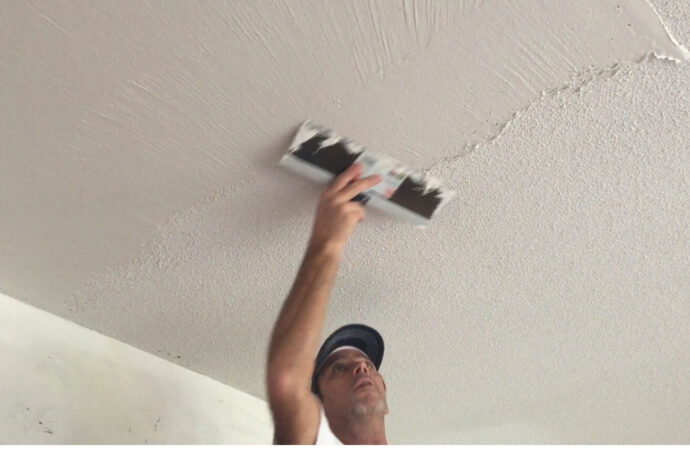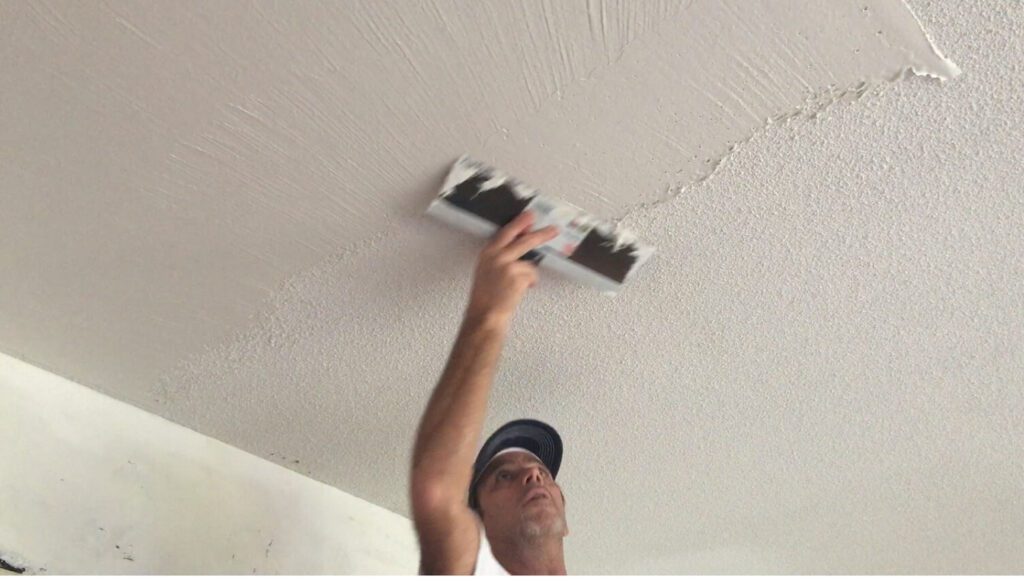You might have thought about having your popcorn ceilings removed. These ceilings can be challenging to paint and require a thick-nap roller cover. You will need to use a lot of paint because the texture absorbs paint like a sponge. Textured ceilings are also notoriously difficult to clean because they trap dust and catch it. Because the peaks cast dark shadows, they can make rooms appear smaller. The texture material may contain asbestos. This can make a room appear smaller. Treat popcorn ceiling texture will depend on whether or not you believe the material is asbestos-containing. Ceiling texture was typical from the 1950s through the 1980s.1 Testing for asbestos is the first step to removing it. You should consult your local environmental and air quality agencies and your permit office to learn about their safety recommendations regarding removing this material. There is a chance that the popcorn texture was also painted with lead additives. The United States banned lead paint in 1978. Therefore, the paint must be tested for lead if the popcorn ceiling was painted before this date. Before you start, make sure to test for lead and asbestos. A home-based asbestos test kit can be purchased that allows you to take a small amount of the texture product off your hands and send it to a laboratory for testing. You can also hire an asbestos remediation expert to help you. You should ensure that the laboratory is accredited by the National Voluntary Laboratory Accreditation Program (NVLAP). When you are conducting an at-home or scrape test, make sure to wear respirators. Popcorn ceiling removal can create a lot of waste. Any surface exposed to water or goopy texture products could be considered. You might want to remove any lightweight furniture and cover the rest. Apply plastic painter’s tape to the walls. Run the edge of the masking tape along the junction between the ceiling and walls. The thicker 6-mil sheet of plastic will be used to cover the flooring. What you’ll need
Wear the proper safety clothing, such as gloves and a dust mask, if you suspect the popcorn texture material may contain asbestos or lead-based paint. Scrape off any textured material after the water has evaporated. At first, use the large scraper. Push the scraper into the softened texture until it touches plaster or drywall. Next, tilt the scraper at a low angle so that the scraper is moving forward. Now the surface should be similar to cottage cheese. It should fall off easily. It is too dry if the material needs to be pushed with great force. Wet it again. You can continue with the ceiling if the sample area is easy to remove. You can work in smaller areas, approximately 4-16 square feet. You should not soak the ceiling in one go. The sections that dry first will be difficult to reach. The narrower scrapers are best used in corners and along edges. The Homax Ceiling Texture Scraper is a specialized scraper that can remove ceiling texture. This scraper can be attached to a plastic bag to catch the texture residue. You need to dry the room and the drywall for a long time because you have brought moisture into the space. Drywall is made of a paper backing and an insulated gypsum core, retaining water for a long time. Drying will be faster if you increase the temperature and allow air ventilation. After removing the ceiling texture, allow the room to dry completely for 24 hours. Ceiling scraping can cause gouges, scratches, and small holes. Use your scraper tools to clean them and apply dust-control drywall compound or spackle to these areas. Use one hundred percent fine-grit sandpaper to smoothen the surface. After sanding, clean the ceiling. Now, prime and paint the ceiling. You can dispose of the debris in contractor bags, provided it contains no hazardous materials. You cannot dispose of texture materials that contain asbestos or lead-based paint with regular landfill waste. You'll need to apply for a permit to dispose of the material separately. This usually happens within a short time (up to 30 Days). You can move on to DIY popcorn ceiling removal only after an asbestos test has been completed and is negative. You may want to hire someone to do the job for you. However, it is possible to save money by doing this project at home. West Palm Beach Popcorn Ceiling Removal & Drywall Pros is the best person to help you remove a textured ceiling after it has been painted. You can’t use the same wetting methods to remove an unpainted popcorn ceiling. A professional with years of experience know how to deal with this situation. Although textured popcorn ceilings were out of fashion many years ago, some older homes and newer ones still have them. Although removing a textured ceiling can be done quickly, it requires special safety precautions and hard work. Two potential problems can make removing a textured roof a nightmare. Acoustic textures made before 1980 could contain asbestos. It should be checked before it is removed. Although it is not dangerous to your health if the ceiling is left intact, lifting a ceiling with asbestos fibers can cause them to get trapped in your lungs. The Environmental Protection Agency website has more information on Asbestos in Your Home. This can make it more difficult to remove a popcorn ceiling. This makes it difficult to remove the texture. Although a painted texture ceiling can be removed with a chemical stripper, this is usually required to remove the paint barrier. Combine a few drops of liquid dishwashing detergent with warm water to determine if your ceiling is affected by either one of these conditions. Spray a small area in a conspicuous place and allow it to absorb the water. The ceiling is painted if the water doesn’t soak in. The ceiling has been painted if the water does not soak in. Use a putty knife or a plastic bag to test for asbestos in ceiling texture that was applied before 1980. A testing service can be hired to take the sample if you are concerned about possible health hazards. Send it to approved testing facilities to determine if the sample contains asbestos. Contact your state’s environmental or health office to find out if there is a testing facility in your area. The EPA website has a list of all state offices. If you find that the material contains more than 1% asbestos, then it is illegal to remove it. You will have to call a professional or leave the ceiling as it is. Even if the ceiling doesn’t contain asbestos, it is essential to use a dust mask or respirator while removing it. It can be messy to remove a popcorn ceiling. The home inspector estimated that it could cost $10,000. This was too expensive for the young couple. They hated the look. They decided to remove the coating by themselves. This is legal in the jurisdiction of the air agency, provided that it is done with a permit. The floor would be covered with thick plastic that runs up the walls. Next, they would tape more plastic to the walls, cover the bottom, and then cover it with plastic. A second layer of plastic would be needed to protect the floors. This will allow any droppings from the ceiling to be wrapped up and removed without contaminating the floor. You would have to wear protective clothing covering your heads down to the feet. To spray the ceilings and remove the coating, they would need various tools and unique plastic bags (available from Home Depot) that can be used to dispose of the waste at the designated place. If you find that the coating is fraying and the test results are positive, you need to take action. Consider the costs of encapsulation and removal. However, an encapsulated layer will not absorb water easily, so removing it may be difficult or more expensive. It is best to leave the coating if it contains asbestos and is not in bad condition. You can remove the layer to improve aesthetics or make room for remodeling. Get bids to remove it from the entire house or for each room. You may also need proposals to move your furniture into the garage or temporary storage while doing whole-house removal. If you don’t have the budget for professional removal and live in an area where you can do the work yourself, you might consider doing the job in smaller rooms. To prevent debris from drying out, it is vital to bag it immediately after you have removed it. Dry fibers can quickly become airborne, and this is when they can become dangerous. We offer the above services at the following locations within West Palm Beach:
If you are located in Palm Beach County and you don’t see your city/area listed above, don’t worry! We cover all of Palm Beach County. Fill out the contact form above or CLICK HERE and send us a message. We’ll get back to you asap!
Popcorn Ceiling Removal
Contact Us

Asbestos testing
Instructions
Take out the texture.
Let the Ceiling Dry
Fix Ceiling Damage
Get rid of your waste.

Asbestos
Paint on the ceiling
Locations We Serve

